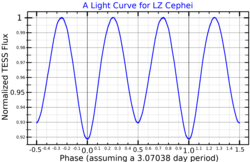Astronomy:LZ Cephei
| Observation data Equinox J2000.0]] (ICRS) | |
|---|---|
| Constellation | Cepheus |
| Right ascension | 22h 02m 04.57263s[2] |
| Declination | +58° 00′ 01.3098″[2] |
| Apparent magnitude (V) | 5.6[3] |
| Characteristics | |
| Spectral type | O 9III (primary) + ON 9.7V (secondary)[4] |
| Variable type | Rotating ellipsoidal variable[5] |
| Astrometry | |
| Proper motion (μ) | RA: −3.096±0.061[2] mas/yr Dec.: −2.611±0.054[2] mas/yr |
| Parallax (π) | 0.9070 ± 0.0525[2] mas |
| Distance | 3,600 ± 200 ly (1,100 ± 60 pc) |
| Orbit[4] | |
| Period (P) | 3.070507 d |
| Eccentricity (e) | 0.0 |
| Inclination (i) | 49±2.4° |
| Semi-amplitude (K1) (primary) | 88.72±1.02 km/s |
| Semi-amplitude (K2) (secondary) | 224.48±2.58 km/s |
| Details | |
| Primary | |
| Mass | 16.0[4] M☉ |
| Radius | 11.7+3.3 −2.7[4] R☉ |
| Luminosity | 79,000[3] L☉ |
| Surface gravity (log g) | 3.71±0.02[3] cgs |
| Temperature | 32,000±1,000[4] K |
| Secondary | |
| Mass | 6.5[4] M☉ |
| Radius | 9.4+2.6 −2.2[4] R☉ |
| Luminosity | 45,000[3] L☉ |
| Surface gravity (log g) | 3.48±0.02[3] cgs |
| Temperature | 28,000±1,000[4] K |
| Other designations | |
| Database references | |
| SIMBAD | data |
LZ Cephei, also known by its Flamsteed designation 14 Cephei, is a star about 3,600 light years from the Earth, in the constellation Cepheus. Its apparent magnitude is 5.6, making it faintly visible to the naked eye of an observer far from city lights.[3] The star is a rotating ellipsoidal variable whose brightness, as measured by the Hipparcos satellite, varies between magnitude 5.52 and 5.61.[5]
LZ Cephei was discovered to be a binary star by William Edmund Harper in 1931.[7] The orbital elements were first calculated by Robert Methven Petrie in 1962.[7] It was discovered to be a variable star in 1972 by N. Kameswara Rao, using the Lick Observatory's 24 inch telescope.[8] The star was given the variable star designation LZ Cephei in 1973.[9] It was classified as an ellipsoidal variable by Hill et al. in 1976.[10]
A 2011 study of LZ Cephei concluded that the existing data are best explained if the system is a semi-detached binary with either the primary or secondary star nearly filling its Roche lobe. The secondary star, now less massive than the primary, was originally the more massive star, and matter has been transferred from the secondary to the primary.[4]
References
- ↑ "MAST: Barbara A. Mikulski Archive for Space Telescopes". Space Telescope Science Institute. https://mast.stsci.edu/portal/Mashup/Clients/Mast/Portal.html.
- ↑ 2.0 2.1 2.2 2.3 2.4 Vallenari, A. et al. (2022). "Gaia Data Release 3. Summary of the content and survey properties". Astronomy & Astrophysics. doi:10.1051/0004-6361/202243940 Gaia DR3 record for this source at VizieR.
- ↑ 3.0 3.1 3.2 3.3 3.4 3.5 Harries, T. J.; Hilditch, R. W.; Hill, G. (April 1998). "Interacting OB star binaries: LZ Cep, SZ Cam and IU AUR". Monthly Notices of the Royal Astronomical Society 295 (2): 386–396. doi:10.1046/j.1365-8711.1998.01340.x. Bibcode: 1998MNRAS.295..386H.
- ↑ 4.0 4.1 4.2 4.3 4.4 4.5 4.6 4.7 4.8 Mahy, L.; Martins, F.; Machado, C.; Donati, J. F.; Bouret, J. C. (September 2011). "The two components of the evolved massive binary LZ Cephei. Testing the effects of binarity on stellar evolution". Astronomy & Astrophysics 533. doi:10.1051/0004-6361/201116993. Bibcode: 2011A&A...533A...9M.
- ↑ 5.0 5.1 Samus', N. N.; Kazarovets, E. V.; Durlevich, O. V.; Kireeva, N. N.; Pastukhova, E. N. (2017). "General catalogue of variable stars: Version GCVS 5.1". Astronomy Reports 61 (1): 80. doi:10.1134/S1063772917010085. Bibcode: 2017ARep...61...80S.
- ↑ "14 Cep -- Spectroscopic Binary". SIMBAD. Centre de données astronomiques de Strasbourg. http://simbad.u-strasbg.fr/simbad/sim-basic?Ident=14+Cep+--+Spectroscopic+Binary.
- ↑ 7.0 7.1 Petrie, R. M. (May 1962). "The O-type spectroscopic binary 14 Cephei". Publications of the Dominion Astrophysical Observatory Victoria 12: 111–116. Bibcode: 1962PDAO...12..111P.
- ↑ Kameswara Rao, N. (August 1972). "Light Variations of Three Spectroscopic Binaries". Publications of the Astronomical Society of the Pacific 84 (500): 563–565. doi:10.1086/129332. Bibcode: 1972PASP...84..563K.
- ↑ Kukarkin, B. V.; Kholopov, P. N.; Kukarkina, N. P. (October 1973). "59th Name-List of Variable Stars". Information Bulletin on Variable Stars 834 (1): 1. Bibcode: 1973IBVS..834....1K.
- ↑ Hill, G.; Hilditch, R. W.; Pfannenschmidt, E. L. (January 1976). "Photoelectric measures of variable stars observed at Mt. Kobau (1970 - 73)". Publications of the Dominion Astrophysical Observatory Victoria 15: 1–35. Bibcode: 1976PDAO...15....1H.
 |


